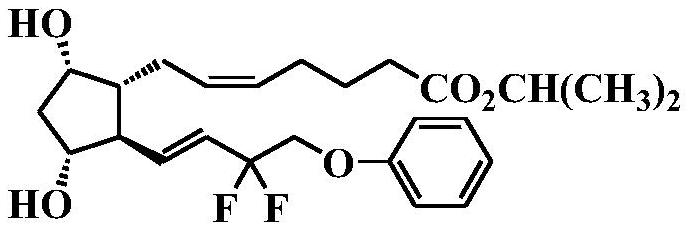The purification method of tafluprost
A technology of tafluprost and tafluprost acid, which is applied in the new purification field of tafluprost, can solve the problems of long manufacturing process, low practicability, and low yield, and achieve the effect of inhibiting decomposition
- Summary
- Abstract
- Description
- Claims
- Application Information
AI Technical Summary
Problems solved by technology
Method used
Image
Examples
Embodiment
[0095] Hereinafter, the present invention will be described in detail with reference to Reference Examples, Examples, and Test Examples, but the present invention is not limited to these.
[0096] % means mol% in yield, and means mass % unless otherwise specified. The ratios shown in the mixed solvent represent volume ratios unless otherwise specified. In addition, room temperature means the temperature of 15-30 degreeC unless otherwise indicated. below 1 The H-NMR value was measured with a nuclear magnetic resonance apparatus JEOL Ltd. ECP400 (400 MHz). The HPLC apparatus used Shimadzu LC-10ADvp or LC-10A. The GC apparatus used Shimadzu GC-2014ATF.
reference example 1
[0097] Reference Example 1: Synthesis of Tafluprost Acid
[0098]
[0099] Under nitrogen atmosphere, in (1S,5R,6R,7R)-6-[(1E)-3,3-difluoro-4-phenoxy-1-butenyl]-7-hydroxy-2-oxygen Tetrahydrofuran (1200 g) was added and dissolved in heterobicyclo[3.3.0]octan-3-one (280 g), and diisobutylaluminum hydride (1M toluene solution) (2160 mL) was added dropwise at -70°C. After completion of the dropwise addition, the mixture was stirred for 30 minutes, 1N hydrochloric acid was added, and extraction was performed with ethyl acetate. After the organic layers were combined and washed with water, the filtrate was concentrated under reduced pressure to obtain a reduced body (284 g). Under a nitrogen atmosphere, tetrahydrofuran (5030 g) was added to 4-carboxybutyltriphenylphosphonium bromide (1523 g), and sodium bis(trimethylsilyl)amide solution (1M tetrahydrofuran solution) (6684 mL) was added dropwise, Stir for more than 1 hour. The above-mentioned reducing body (286 g) dissolved in ...
reference example 2
[0101] Reference Example 2: Synthesis of Tafluprost Crude Product
[0102]
[0103] Tafluprost acid (120 g) obtained in Reference Example 1 was put into a 5 L flask under a nitrogen atmosphere, and dissolved in acetone (600 mL) with stirring. It was cooled to 5°C, and 1,8-diazabicyclo[5.4.0]undec-7-ene (DBU) (160 mL) was added dropwise while keeping the temperature below 5°C, and further dropped while keeping the temperature below 5°C. After adding 2-iodopropane (146 mL), the mixture was stirred at 30° C. until the conversion rate of the reaction was over 95%. Ethyl acetate (1800 mL) and 5% citric acid aqueous solution (900 mL) were added to the reaction mixture, and the layers were separated, and 5% citric acid aqueous solution (900 mL, once), 5% sodium bicarbonate aqueous solution (900 mL, twice), and purified water (900 mL, once) to wash the organic layer. Under reduced pressure, the solvent was distilled off at below 40°C to obtain a crude tafluprost product (132 g, y...
PUM
| Property | Measurement | Unit |
|---|---|---|
| particle diameter | aaaaa | aaaaa |
| viscosity | aaaaa | aaaaa |
| particle diameter | aaaaa | aaaaa |
Abstract
Description
Claims
Application Information
 Login to View More
Login to View More - R&D
- Intellectual Property
- Life Sciences
- Materials
- Tech Scout
- Unparalleled Data Quality
- Higher Quality Content
- 60% Fewer Hallucinations
Browse by: Latest US Patents, China's latest patents, Technical Efficacy Thesaurus, Application Domain, Technology Topic, Popular Technical Reports.
© 2025 PatSnap. All rights reserved.Legal|Privacy policy|Modern Slavery Act Transparency Statement|Sitemap|About US| Contact US: help@patsnap.com



